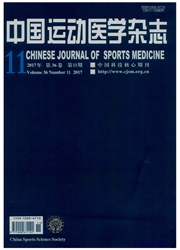

 中文摘要:
中文摘要:
目的:探讨高住高练低训(HiHiLo)对运动员安静状态下左心室功能的影响。方法:大学生运动员在O2浓度相当于海拔2800m-3000m的常压低氧舱房每天居住10小时,在O2浓度相当于海拔2500m-2600m的室内每周训练3次,期间维持常氧训练,实验为期4周;采用超声心动图技术,于HiHiLo前后分别测量48名受试者心脏在安静时的形态结构学指标、收缩功能指标及舒张功能指标。结果:与HiHiLo前相比,4周后受试者左心室形态结构学指标中的LVIDd(左室舒张末期内径)、LVM(左室心肌质量)和LVMI(左室心肌质量指数)分别增加了0.93%(P=0.007)、2.87%(P=0.009)和3.59%(P=0.002);泵功能及舒张功能方面,SV(每搏量)、SI(每搏指数)和EDV(舒张末期容积)分别增加了1.99%(P=0.001)、2.71%(P=0.000)和0.97%(P=0.032),且DSV(每搏量变化量)与DEDV(舒张末期容积变化量)之间存在相关关系;DP(二项乘积)下降了9.35%(P=0.000)。结论:4周HiHiLo后受试者的左心室除产生了生理性肥厚外,其泵功能也显著改善,主要体现在舒张功能明显增强,而且心肌耗能趋向节约化。
 英文摘要:
英文摘要:
Objective To determine the effect of living at high altitude--exercise at high altitude--training at low altitude (HiHiLo) on athlete's left ventricular (LV) function at rest. Methods forty eight collegiate athletes were asked to spent 10 hours per night in a N2 chamber with the concentration of O2 equal to altitude of 2800m- 3000m, to train 3 times per week in the chamber simulated altitude of 2500m-2600m, and to exercise at sea level. Resting echocardiography was performed in the subjects before and after 4-- week HiHiLo. Results LVIDd (left ventricular end--diastolic internal diameter), LVM (left ventricular mass), LVMI (left ventricular mass index) increased by a percentage of 0.93 (P=0. 007), 2.87 (P=0. 009), 3.59 (P:0. 002), respectively. SV (stroke volume), SI (stroke index) and EDV (end--diastolic volume) increased 1.99% (P=0. 001), 2.71% (P=0. 000) and 0.97% (P=0. 032), respectively. A significant linear correlation was found between DSV (difference of SV) and DEDV (difference of EDV). A significant reduction of 9.35% (P = 0. 000) from baseline was found in DP (double product). Conclusion After 4 weeks of HiHiLo, besides the physiological LV hypertrophy, improved pump function and reduced energy-consumption in the heart of subjects was found.
 同期刊论文项目
同期刊论文项目
 同项目期刊论文
同项目期刊论文
 期刊信息
期刊信息
